交替传译与同声传译的比较
- 格式:pdf
- 大小:324.52 KB
- 文档页数:73
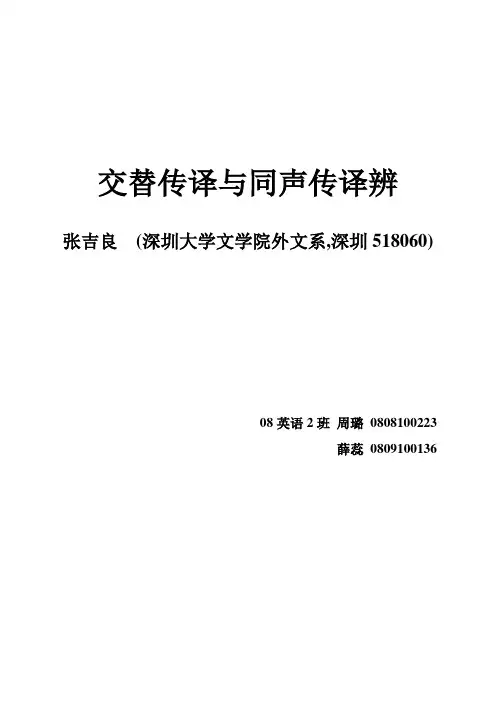
交替传译与同声传译辨张吉良(深圳大学文学院外文系,深圳518060)08英语2班周璐0808100223薛蕊0809100136一、引言(一)口译的主要工作方式:1.交替传译:译员在听辨来源语语音符号的同时,借助主题和认知知识以及口译笔记,待讲话人完成部分或全部发言后,随即用目的语传达给听众。
2.同声传译:译员在听辨来源语语音符号的同时,借助主题和认识知识,同时用目的语把讲话人所表达的信息以口头形式几乎同步地重新表述出来。
(二)本文拟从以下几个方面对交替传译和同声传译的过程比较相似性以及差异:1.口译工作程序2.译员注意力分配3.记忆方式4.脱离原语语言外壳5.译语发布与译语质量6.译语质量评判7.译员的工作方式及其影响8.口译技术9.对译员的素质要求二、交替传译与同声传译的异同(一)交替传译和同声传译的工作程序1.巴黎释意学派翻译理论将口译工作程序分为三个步骤:1)在原语语音符号的接收过程中,启动语言外知识,使之与语言知识相结合,建立原语语篇层次的意义。
2) 丢开原语措辞,即脱离原语语言外壳,记忆原语所表达的信息。
3) 以目的语为载体,对原语信息进行编码,并发布译语。
2.交替传译工作程序特点:1) 呈“历时性”线状展开,译语发布在原语讲话的片断或全文结束之后。
2) 更容易启动认识知识,克服原语词汇和句式的束缚。
3) 在口译笔记的帮助下,借助短时记忆力记忆原语信息发布译语。
3.同声传译工作程序特点:1) 呈“共时性”,原语信息发布与译员对原语信息的接收、脱离原语语言外壳、译语产出等几乎是同时发生的。
2) 译员对原语的接收、理解、记忆和译语的组织、整理、发布与监听、修正过程都被最大限度地压缩了3) 能够对原语讲话内容进行持续不断的有效预测。
4) 译员需根据原语讲话的题材、体裁、语速、讲话的方式以及对原语的理解程度、译员的个人爱好等因素来确定原语与译语间的时差幅度。
(二)交替传译和同声传译对译员注意力分配的影响1.交替传译:1) 译员的信息接收和译语发布是先后分开进行的。
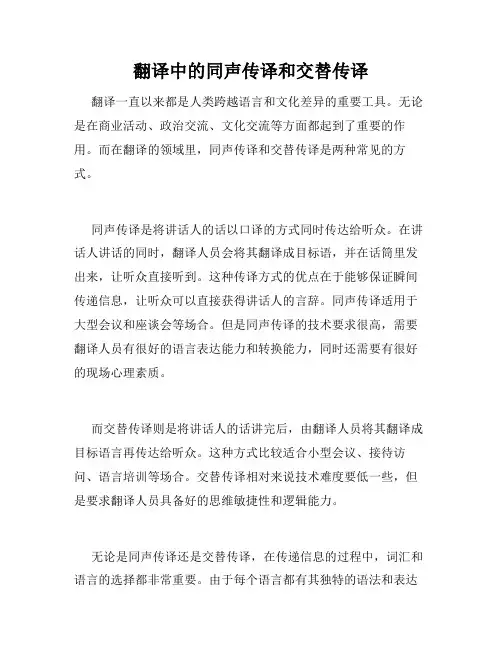
翻译中的同声传译和交替传译翻译一直以来都是人类跨越语言和文化差异的重要工具。
无论是在商业活动、政治交流、文化交流等方面都起到了重要的作用。
而在翻译的领域里,同声传译和交替传译是两种常见的方式。
同声传译是将讲话人的话以口译的方式同时传达给听众。
在讲话人讲话的同时,翻译人员会将其翻译成目标语,并在话筒里发出来,让听众直接听到。
这种传译方式的优点在于能够保证瞬间传递信息,让听众可以直接获得讲话人的言辞。
同声传译适用于大型会议和座谈会等场合。
但是同声传译的技术要求很高,需要翻译人员有很好的语言表达能力和转换能力,同时还需要有很好的现场心理素质。
而交替传译则是将讲话人的话讲完后,由翻译人员将其翻译成目标语言再传达给听众。
这种方式比较适合小型会议、接待访问、语言培训等场合。
交替传译相对来说技术难度要低一些,但是要求翻译人员具备好的思维敏捷性和逻辑能力。
无论是同声传译还是交替传译,在传递信息的过程中,词汇和语言的选择都非常重要。
由于每个语言都有其独特的语法和表达方式,因此翻译人员需要考虑到词语的准确性、用语的恰当性、声音和语速的调整等因素。
同时,翻译人员还需要考虑到场合和讲话人的语言风格,尽量使翻译的风格贴近讲话人,让听众可以更好的理解讲话人的思想。
除了翻译人员的能力和技术,现代科技也为同声传译和交替传译提供了很好的支持。
语音识别和机器翻译的发展,可以让翻译人员更好地完成翻译任务。
当然,这些技术也有其局限性,不能完全代替人类翻译的能力和思维活动。
总之,同声传译和交替传译在翻译领域中都起到了很重要的作用。
无论是在商业场合、政治交流、文化交流等方面,都需要翻译人员用心去把握每个瞬间,将语言和文化差异化成跨越界限的桥梁。
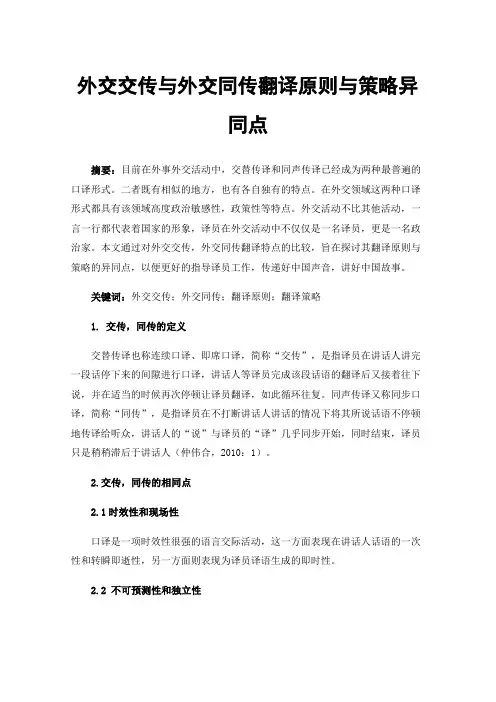
外交交传与外交同传翻译原则与策略异同点摘要:目前在外事外交活动中,交替传译和同声传译已经成为两种最普遍的口译形式。
二者既有相似的地方,也有各自独有的特点。
在外交领域这两种口译形式都具有该领域高度政治敏感性,政策性等特点。
外交活动不比其他活动,一言一行都代表着国家的形象,译员在外交活动中不仅仅是一名译员,更是一名政治家。
本文通过对外交交传,外交同传翻译特点的比较,旨在探讨其翻译原则与策略的异同点,以便更好的指导译员工作,传递好中国声音,讲好中国故事。
关键词:外交交传;外交同传;翻译原则;翻译策略1.交传,同传的定义交替传译也称连续口译、即席口译,简称“交传”,是指译员在讲话人讲完一段话停下来的间隙进行口译,讲话人等译员完成该段话语的翻译后又接着往下说,并在适当的时候再次停顿让译员翻译,如此循环往复。
同声传译又称同步口译,简称“同传”,是指译员在不打断讲话人讲话的情况下将其所说话语不停顿地传译给听众,讲话人的“说”与译员的“译”几乎同步开始,同时结束,译员只是稍稍滞后于讲话人(仲伟合,2010:1)。
2.交传,同传的相同点2.1时效性和现场性口译是一项时效性很强的语言交际活动,这一方面表现在讲话人话语的一次性和转瞬即逝性,另一方面则表现为译员译语生成的即时性。
2.2不可预测性和独立性从某种意义上说,口译是一项独立性、不可预测性很强的信息交流活动。
对于口译员来说,一旦接手一项口译任务,就无从自行选择工作场景,而且在多数情况下要独立完成口译工作。
无论译员进行了怎样细致的译前准备,他/她依然可能在工作中遭遇这样或那样难以预知的问题,如理解、记忆、笔记和沟通协调问题,还可能出现心理压力过大或体力不支等问题。
有些问题即使不是译员自身造成的,也会对口译质量和效果产生很大影响,如音响效果不好,工作环境很差,讲话人声音很小、语速过快等等。
(任文,2012:5)。
3交传,同传不同点3.1时间性对同声传译而言,听(输入)与说(输出)在保持一定时间差的前提下同步进行,而交传是在讲话人停顿以后才开始翻译,因此交传活动所耗费的时间往往是同传活动的一倍左右。
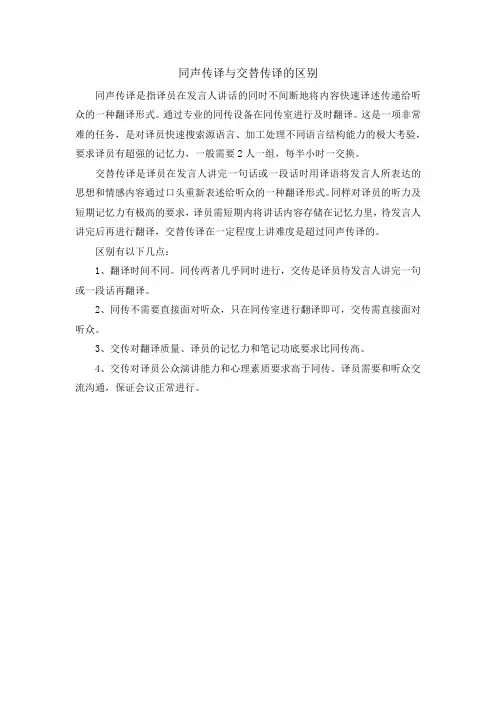
同声传译与交替传译的区别
同声传译是指译员在发言人讲话的同时不间断地将内容快速译述传递给听众的一种翻译形式。
通过专业的同传设备在同传室进行及时翻译。
这是一项非常难的任务,是对译员快速搜索源语言、加工处理不同语言结构能力的极大考验,要求译员有超强的记忆力,一般需要2人一组,每半小时一交换。
交替传译是译员在发言人讲完一句话或一段话时用译语将发言人所表达的思想和情感内容通过口头重新表述给听众的一种翻译形式。
同样对译员的听力及短期记忆力有极高的要求,译员需短期内将讲话内容存储在记忆力里,待发言人讲完后再进行翻译,交替传译在一定程度上讲难度是超过同声传译的。
区别有以下几点:
1、翻译时间不同。
同传两者几乎同时进行,交传是译员待发言人讲完一句或一段话再翻译。
2、同传不需要直接面对听众,只在同传室进行翻译即可,交传需直接面对听众。
3、交传对翻译质量、译员的记忆力和笔记功底要求比同传高。
4、交传对译员公众演讲能力和心理素质要求高于同传。
译员需要和听众交流沟通,保证会议正常进行。
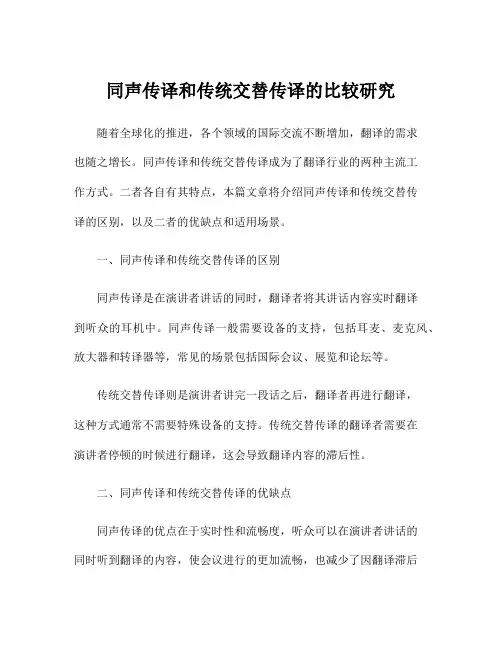
同声传译和传统交替传译的比较研究随着全球化的推进,各个领域的国际交流不断增加,翻译的需求也随之增长。
同声传译和传统交替传译成为了翻译行业的两种主流工作方式。
二者各自有其特点,本篇文章将介绍同声传译和传统交替传译的区别,以及二者的优缺点和适用场景。
一、同声传译和传统交替传译的区别同声传译是在演讲者讲话的同时,翻译者将其讲话内容实时翻译到听众的耳机中。
同声传译一般需要设备的支持,包括耳麦、麦克风、放大器和转译器等,常见的场景包括国际会议、展览和论坛等。
传统交替传译则是演讲者讲完一段话之后,翻译者再进行翻译,这种方式通常不需要特殊设备的支持。
传统交替传译的翻译者需要在演讲者停顿的时候进行翻译,这会导致翻译内容的滞后性。
二、同声传译和传统交替传译的优缺点同声传译的优点在于实时性和流畅度,听众可以在演讲者讲话的同时听到翻译的内容,使会议进行的更加流畅,也减少了因翻译滞后带来的误解。
此外,同声传译只需要一个翻译者,可以缩短会议的时间。
但同声传译也存在一些缺点。
首先,同声传译需要额外的设备支持,这使得成本较高。
其次,同声传译需要翻译者具备较强的口语表达能力和实时翻译能力,这对翻译者的能力有较高的要求。
最后,由于时间紧迫,同声传译的翻译者需要时刻保持高度集中以及良好的体力和心理素质。
传统交替传译的优点在于不需要特殊设备的支持和可以适应各种场景,同时可以避免在演讲者讲话时翻译者的干扰,同时对翻译者的能力要求相对较低。
但传统交替传译的缺点在于翻译滞后性较大,容易因语言表达不够精准而造成误解;此外,对于长时间的会议,传统交替传译会耗费较长时间,也可能会影响会议的进行。
三、适用场景同声传译适合于对实时性有较高要求的场景,如国际会议,大型展览等;传统交替传译适用于一些较小型的会议和交流场合,如商务谈判、场馆导览等,同时也适用于一个演讲者讲完整段话之后再进行翻译的场景。
总得来说,同声传译和传统交替传译各有优劣,不同的翻译需求和场景可以选择不同的翻译方式。
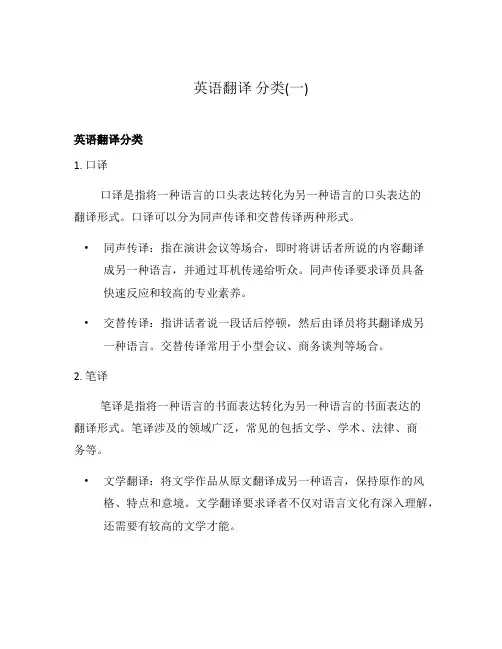
英语翻译分类(一)英语翻译分类1. 口译口译是指将一种语言的口头表达转化为另一种语言的口头表达的翻译形式。
口译可以分为同声传译和交替传译两种形式。
•同声传译:指在演讲会议等场合,即时将讲话者所说的内容翻译成另一种语言,并通过耳机传递给听众。
同声传译要求译员具备快速反应和较高的专业素养。
•交替传译:指讲话者说一段话后停顿,然后由译员将其翻译成另一种语言。
交替传译常用于小型会议、商务谈判等场合。
2. 笔译笔译是指将一种语言的书面表达转化为另一种语言的书面表达的翻译形式。
笔译涉及的领域广泛,常见的包括文学、学术、法律、商务等。
•文学翻译:将文学作品从原文翻译成另一种语言,保持原作的风格、特点和意境。
文学翻译要求译者不仅对语言文化有深入理解,还需要有较高的文学才能。
•学术翻译:将学术论文、研究报告等从一种语言翻译成另一种语言,保持原文的准确性和专业性。
学术翻译要求译者对相关学科领域有深入了解,并具备翻译学术文献的能力。
•法律翻译:将法律文件、法规条款等从一种语言翻译成另一种语言,保持法律意义的准确性和法律语言的规范性。
法律翻译要求译者熟悉法律专业术语和法律体系,具备良好的法律素养。
•商务翻译:将商务文件、商务谈判等从一种语言翻译成另一种语言,保持商务用语的准确性和商务文化的妥当性。
商务翻译要求译者具备商业常识和跨文化沟通技巧。
3. 机器翻译机器翻译是指使用计算机等自动化设备进行翻译的技术和方法。
机器翻译通过分析源语言和目标语言之间的句法结构和语义关系,自动将源语言的内容转化为目标语言。
机器翻译具有高效性和大规模处理能力,但仍面临语义理解和文化差异等挑战。
•统计机器翻译:基于大规模并行语料库的统计模型,通过计算句子的概率分布进行翻译。
统计机器翻译依赖大量的双语平行语料,准确性受限于语料库的质量和覆盖范围。
•神经机器翻译:基于神经网络模型的机器翻译,通过训练深度神经网络来建模源语言和目标语言之间的映射关系。
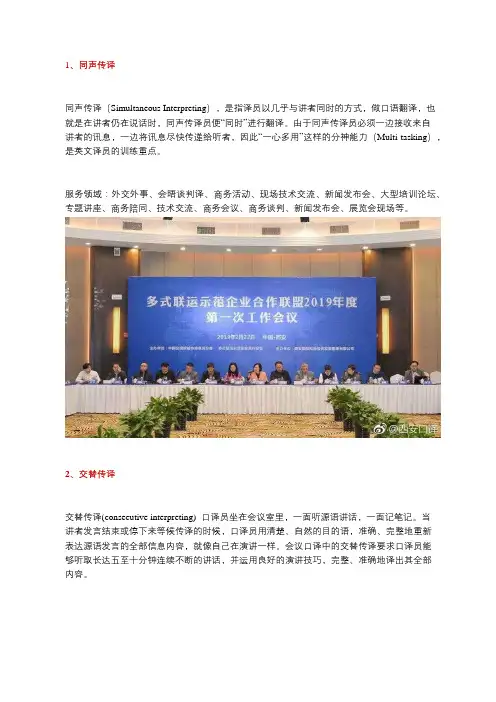
1、同声传译同声传译(Simultaneous Interpreting),是指译员以几乎与讲者同时的方式,做口语翻译,也就是在讲者仍在说话时,同声传译员便“同时”进行翻译。
由于同声传译员必须一边接收来自讲者的讯息,一边将讯息尽快传递给听者,因此“一心多用”这样的分神能力(Multi-tasking),是英文译员的训练重点。
服务领域:外交外事、会晤谈判译、商务活动、现场技术交流、新闻发布会、大型培训论坛、专题讲座、商务陪同、技术交流、商务会议、商务谈判、新闻发布会、展览会现场等。
2、交替传译交替传译(consecutive interpreting)- 口译员坐在会议室里,一面听源语讲话,一面记笔记。
当讲者发言结束或停下来等候传译的时候,口译员用清楚、自然的目的语,准确、完整地重新表达源语发言的全部信息内容,就像自己在演讲一样。
会议口译中的交替传译要求口译员能够听取长达五至十分钟连续不断的讲话,并运用良好的演讲技巧,完整、准确地译出其全部内容。
服务领域:外交会晤,双边谈判,中型会议,技术交流会,随堂口译,商务谈判,高级别的学术会议,学术交流会,访问考察,小范围磋商,司法和准司法程序,宴会致词,记者采访,新闻发布会,展览会洽谈等。
3、陪同口译陪同口译是指在各类晚会或商务活动中担当中文以及另一种外语翻译的口译人员。
涉及外语导游、购物陪同、旅游口译、商务口译等. 包括展会口译、参观口译、聚会口译、联络、接待、参观、浏览等活动。
服务领域:陪同口译主要涉及领域:商务陪同、旅游陪同、国家机关、学校、涉外单位、外资企业等各类企事业单位的各类陪同口译服务;商务访问接待、外事访问接待,日常生活交流。
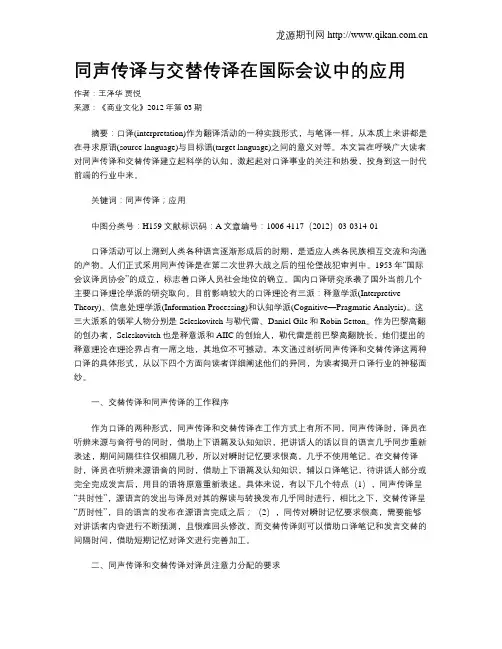
同声传译与交替传译在国际会议中的应用作者:王泽华贾悦来源:《商业文化》2012年第03期摘要:口译(interpretation)作为翻译活动的一种实践形式,与笔译一样,从本质上来讲都是在寻求原语(source language)与目标语(target language)之间的意义对等。
本文旨在呼唤广大读者对同声传译和交替传译建立起科学的认知,激起起对口译事业的关注和热爱,投身到这一时代前端的行业中来。
关键词:同声传译;应用中图分类号:H159 文献标识码:A文章编号:1006-4117(2012)03-0314-01口译活动可以上溯到人类各种语言逐渐形成后的时期,是适应人类各民族相互交流和沟通的产物。
人们正式采用同声传译是在第二次世界大战之后的纽伦堡战犯审判中。
1953年“国际会议译员协会”的成立,标志着口译人员社会地位的确立。
国内口译研究承袭了国外当前几个主要口译理论学派的研究取向。
目前影响较大的口译理论有三派:释意学派(Interpretive Theory)、信息处理学派(Information Processing)和认知学派(Cognitive—Pragmatic Analysis)。
这三大派系的领军人物分别是Seleskovitch与勒代雷、Daniel Gile和Robin Setton。
作为巴黎高翻的创办者,Seleskovitch也是释意派和AIIC的创始人,勒代雷是前巴黎高翻院长,她们提出的释意理论在理论界占有一席之地,其地位不可撼动。
本文通过剖析同声传译和交替传译这两种口译的具体形式,从以下四个方面向读者详细阐述他们的异同,为读者揭开口译行业的神秘面纱。
一、交替传译和同声传译的工作程序作为口译的两种形式,同声传译和交替传译在工作方式上有所不同,同声传译时,译员在听辨来源与音符号的同时,借助上下语篇及认知知识,把讲话人的话以目的语言几乎同步重新表述,期间间隔往往仅相隔几秒,所以对瞬时记忆要求很高,几乎不使用笔记。
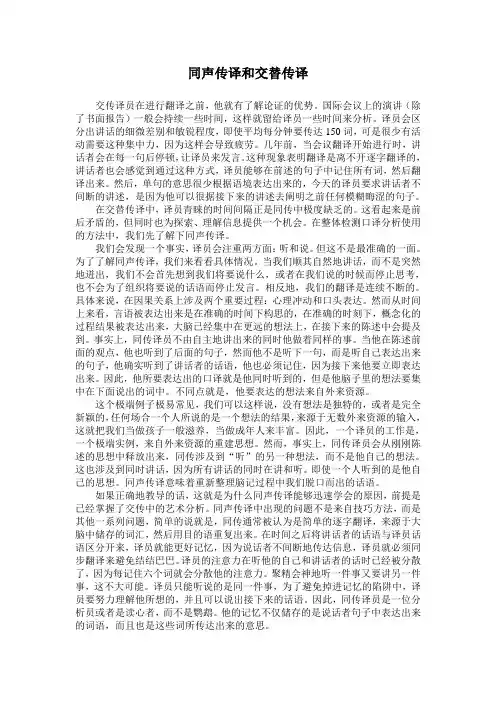
同声传译和交替传译交传译员在进行翻译之前,他就有了解论证的优势。
国际会议上的演讲(除了书面报告)一般会持续一些时间,这样就留给译员一些时间来分析。
译员会区分出讲话的细微差别和敏锐程度,即使平均每分钟要传达150词,可是很少有活动需要这种集中力,因为这样会导致疲劳。
几年前,当会议翻译开始进行时,讲话者会在每一句后停顿,让译员来发言。
这种现象表明翻译是离不开逐字翻译的,讲话者也会感觉到通过这种方式,译员能够在前述的句子中记住所有词,然后翻译出来。
然后,单句的意思很少根据语境表达出来的,今天的译员要求讲话者不间断的讲述,是因为他可以很据接下来的讲述去阐明之前任何模糊晦涩的句子。
在交替传译中,译员青睐的时间间隔正是同传中极度缺乏的。
这看起来是前后矛盾的,但同时也为探索、理解信息提供一个机会。
在整体检测口译分析使用的方法中,我们先了解下同声传译。
我们会发现一个事实,译员会注重两方面:听和说。
但这不是最准确的一面。
为了了解同声传译,我们来看看具体情况。
当我们顺其自然地讲话,而不是突然地迸出,我们不会首先想到我们将要说什么,或者在我们说的时候而停止思考,也不会为了组织将要说的话语而停止发言。
相反地,我们的翻译是连续不断的。
具体来说,在因果关系上涉及两个重要过程:心理冲动和口头表达。
然而从时间上来看,言语被表达出来是在准确的时间下构思的,在准确的时刻下,概念化的过程结果被表达出来,大脑已经集中在更远的想法上,在接下来的陈述中会提及到。
事实上,同传译员不由自主地讲出来的同时他做着同样的事。
当他在陈述前面的观点,他也听到了后面的句子,然而他不是听下一句,而是听自己表达出来的句子,他确实听到了讲话者的话语,他也必须记住,因为接下来他要立即表达出来。
因此,他所要表达出的口译就是他同时听到的,但是他脑子里的想法要集中在下面说出的词中。
不同点就是,他要表达的想法来自外来资源。
这个极端例子极易常见,我们可以这样说,没有想法是独特的,或者是完全新颖的,任何场合一个人所说的是一个想法的结果,来源于无数外来资源的输入,这就把我们当做孩子一般滋养,当做成年人来丰富。
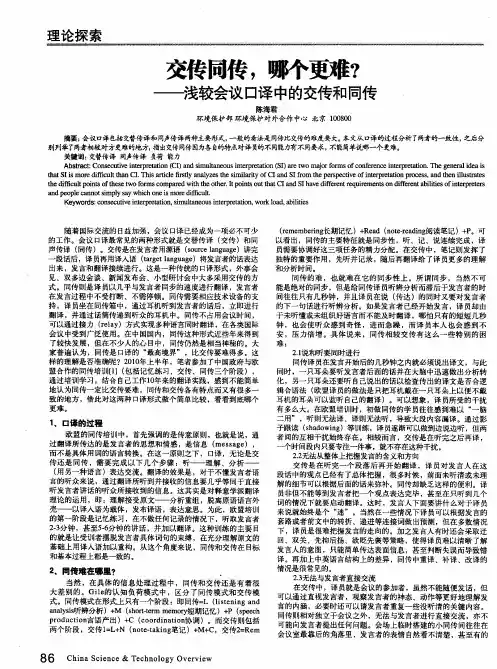
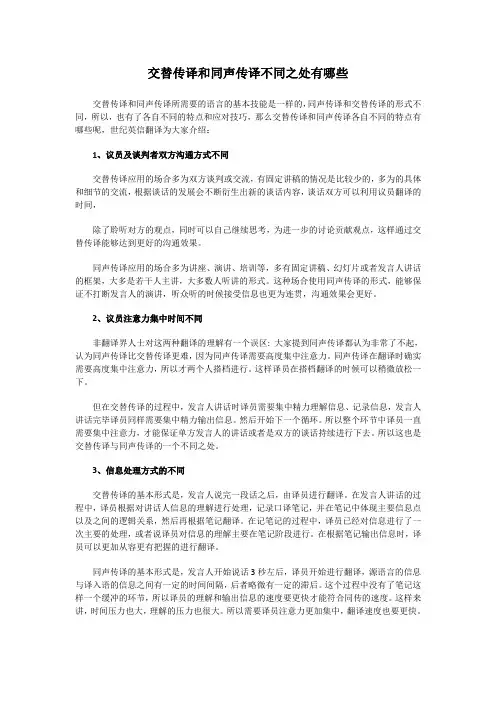
交替传译和同声传译不同之处有哪些交替传译和同声传译所需要的语言的基本技能是一样的,同声传译和交替传译的形式不同,所以,也有了各自不同的特点和应对技巧,那么交替传译和同声传译各自不同的特点有哪些呢,世纪英信翻译为大家介绍:1、议员及谈判者双方沟通方式不同交替传译应用的场合多为双方谈判或交流,有固定讲稿的情况是比较少的,多为的具体和细节的交流,根据谈话的发展会不断衍生出新的谈话内容,谈话双方可以利用议员翻译的时间,除了聆听对方的观点,同时可以自己继续思考,为进一步的讨论贡献观点,这样通过交替传译能够达到更好的沟通效果。
同声传译应用的场合多为讲座、演讲、培训等,多有固定讲稿、幻灯片或者发言人讲话的框架,大多是若干人主讲,大多数人听讲的形式。
这种场合使用同声传译的形式,能够保证不打断发言人的演讲,听众听的时候接受信息也更为连贯,沟通效果会更好。
2、议员注意力集中时间不同非翻译界人士对这两种翻译的理解有一个误区: 大家提到同声传译都认为非常了不起,认为同声传译比交替传译更难,因为同声传译需要高度集中注意力。
同声传译在翻译时确实需要高度集中注意力,所以才两个人搭档进行。
这样译员在搭档翻译的时候可以稍微放松一下。
但在交替传译的过程中,发言人讲话时译员需要集中精力理解信息、记录信息,发言人讲话完毕译员同样需要集中精力输出信息。
然后开始下一个循环。
所以整个环节中译员一直需要集中注意力,才能保证单方发言人的讲话或者是双方的谈话持续进行下去。
所以这也是交替传译与同声传译的一个不同之处。
3、信息处理方式的不同交替传译的基本形式是,发言人说完一段话之后,由译员进行翻译。
在发言人讲话的过程中,译员根据对讲话人信息的理解进行处理,记录口译笔记,并在笔记中体现主要信息点以及之间的逻辑关系,然后再根据笔记翻译。
在记笔记的过程中,译员已经对信息进行了一次主要的处理,或者说译员对信息的理解主要在笔记阶段进行。
在根据笔记输出信息时,译员可以更加从容更有把握的进行翻译。
来越多。
作为口译的两种主要形式,基于各种交流目的,同声传译和交替传译应用于多种不同的场合,并且受到社会的广泛欢迎。
它们都有各自不同的特点和优势。
大多数人认为,同声传译要难于交替传译,而且对译员的能力要求更强。
实际上,无论交替传译还是同声传译,其目的均在于让使用不同语言的人能够实现清晰、无障碍的即时沟通。
会议口译层次上的交替传译和同声传译并没有高低难易之分,两种口译模式相辅相成,且其功能以及对质量的要求是完全相同的。
今天北京翻译公司就和大家分享这两种口译模式都有哪些不同之处。
首先就是定义上的不同,同声传译是指译员在不打断讲话者讲话的情况下,不间断地将内容口译给听众的一种翻译方式,同声传译员通过专用的设备提供即时的翻译,这种方式适用于大型的研讨会和国际会议,通常由两名到三名译员轮换进行。
而交替传译是交互式传译的简称,指说话者说完一段话后,翻译人员再进行翻译,准确度较高,专业的翻译人员可以达到90%以上。
其次,交替传译对译员笔记技艺的要求高于同声传译。
在提供交替传译服务时,译员必须具备扎实过硬的笔记技巧,一次成功的交传离不开译员娴熟的笔记技巧。
译员必须经过大量的练习和实践才能不断完善笔记技巧,而且译员容易在笔记和理解消化原语并信息的精力分配上失衡,很容易顾此失彼。
再者,交传在听力上难于同传。
大家应该知道理解是翻译的前提,也是翻译的关键。
交替传译由于自身的特点,译员必须在演讲者讲话持续一段时间后才能进行翻译,因此对译员的听力有很高的要求,尤其是某些演讲者由于情绪激动,讲话持续很长时间,这就需要交传译员承担较大的听力负荷。
会晤、双边谈判、访问考察、小范围磋商、记者采访、司法和准司法程序、宴会致词、新闻发布会以及时间短的小型研讨会等。
同声传译由于其具有不占用会议时间的优势,已发展成为会议口译中最常用的模式,广泛应用于各种国际场合。
几乎所有正式的国际多语言会议以及国际组织(如联合国和欧盟)都采用了同传作为标准口译模式。
会议同传服务方案同传服务是指在会议、研讨会或商务谈判等场合中,通过专业的口译人员将发言人的讲话实时翻译成听众的母语,以达到双方交流沟通的目的。
同传服务在跨国企业、国际组织、政府机构等领域中广泛应用,为不同语言和文化背景的人们提供了便利。
一、现场同传服务现场同传服务是最常见的一种同传方式,适用于各类大型会议、论坛和座谈会等活动。
一般会提供两种形式的现场同传服务,即同声传译和交替传译。
1. 同声传译:同声传译是指口译人员在发言人和听众同时进行翻译。
此种方式要求口译人员使用专业的同声传译设备,将发言人的讲话内容即时传送到听众耳机中。
同声传译在国际大型会议等场合中应用广泛,能够实时传递信息,提高会议效率。
2. 交替传译:交替传译是指口译人员在发言完成后进行翻译。
此种方式适用于小型会议和座谈会等场合,口译人员可以根据需要进行即时翻译,不需要借助传译设备。
二、远程同传服务远程同传服务是指通过互联网技术,将口译人员与会议现场通过网络连接起来,进行远程翻译服务。
远程同传服务具有时间和地域上的灵活性,可以节约成本,提高效率。
在跨国会议、国际科技交流等场合,远程同传服务能够实现千里不同音,为参会人员提供优质的翻译服务。
三、同传设备供应除了提供专业的同传人员,同传服务方案还需要提供相应的同传设备。
常见的同传设备包括耳机、同声传译设备、发言人麦克风等。
同传设备的品质和性能对于会议的顺利进行和翻译效果的好坏具有重要影响,因此同传服务方案应提供高质量的同传设备。
四、专业的同传团队同传服务方案应提供专业的同传团队,包括资深的口译人员、翻译项目经理和技术支持人员。
资深的口译人员应具备良好的口译能力和一定的主题领域知识,能够熟练应对各类场合的口译工作。
翻译项目经理负责协调整个项目的进程,确保翻译质量和交付时间的准确性。
技术支持人员负责安装、调试和维护同传设备,确保会议现场设备的正常使用。
五、定制化的方案不同的会议和场合有不同的需求,同传服务方案应根据客户的具体需求进行定制。
十年来交替传译和同声传译技巧综述_口译技巧论文导读::本文通过对近年国内外语类期刊杂志及论文的口译技巧研究文章的分类和分析,发现我国的口译技巧研究尽管取得了长足的进步,仍存在一些不足,如在同传方面,口译技巧的研究还很缺乏;而在交传方面除了对笔记技巧的研究较多外,其余技巧都很不足。
论文关键词:交替传译,同声传译,口译技巧口译是通过口头表达将信息从一种语言形式忠实的转换成另一种语言形式的交流过程,在跨文化交际的过程中发挥了桥梁作用。
口译的存在已有很长的历史,其起源可追溯到远古时代,但是与已经经历了两千多年发展的笔译研究相比,口译研究开始较晚。
近年来,由于我国与世界各国的交流日益加强,对专业口译人才的需求与日俱增,口译实践有了长足的进步,口译研究也得到了学术界越来越多的关注。
口译有多种工作方式,其中最主要的是交替传译和同声传泽。
交替传译时,译员在听辨来源语语音符号的同时.借助主题和认知知识以及口译笔记口译技巧,正确地理解和记忆原语语篇意义.待讲话人完成部分或全部发言后,随即用目的语把讲话人所表达的信息以口头形式迅速地重新传达给听众。
与交替传译不同的是,同声传译时,译员在听辨来源语语音符号的同时,用目的语把讲话人所表达的信息以口头形式几乎同步地重新表述出来。
口译是一种要求非常高的任务,在口译的整个过程中存在着不少困难和障碍。
因此要保证口译任务的顺利完成,口译员必须掌握一定的技巧。
但是目前对口译技能的研究还相对较少。
本文选材于2001年——2009年间国内出版的翻译和语言类各种期刊杂志及硕博士论文,其中包括《中国翻译》、《上海翻译》、《中国科技翻译》等核心刊物和各大学院期刊。
笔者从中选出了关于口译研究的文章共381篇,并将这些文章按照不同的口译方式分成两大类,其中关于同声传译方向有294篇文章,其余87篇则是关于交替传译。
最后计算记忆、笔记、增译、补译技巧在这些文章中所占比例,得此表中国期刊全文数据库。
记忆百分比笔记百分比增译百分比补译百分比总共同声传译165.4%0.0%31.0%0.0%294交替传译1112.3%3540.2%11.1%0.0%87从上述表格中我们可以看出在同声传译方面,更多文章是在做非技巧研究,只有 6.2%的文章是在阐述口译中的具体技巧,提出有针对性的对策和解决办法。
口译的主要形式口译根据信息的传送形式,可分为交替传译和同声传译两大类。
根据口译场合和内容又可分为会议口译(conference interpreting)、商务口译(business interpreting)、法庭口译(court interpreting)、媒体口译(media interpreting)、社区口译(community Interpreting)和电话口译(telephone interpreting)等等。
1.交替传译(consecutive interpreting)交替传译亦称连续传译,是指口译员在讲话人讲完部分内容停下来后立刻将其翻译给听众,译完后讲话人再继续讲,译员再译。
讲话和口译交替进行,故称交替传译。
2.同声传译同声传译的应用始于20世纪20年代,而真正引起世人关注则在纽伦堡的二战战犯审判期问。
当时,英语、法语、俄语和德语多种语言同时登场。
自20世纪50年代以来,同声传译被广泛应用于各种国际会议,联合国和欧盟等国际组织都大量使用同声传译。
同声传译大致有以下两种方式:译员坐在同传箱(booth)里,利用大会同传设备,通过耳机收听到讲话,与此同时通过话筒将发言人讲话内容由原语译成目的语。
这种形式是最常见的会议同声传译。
口译员将发言人的讲话同步、小声地直接译给身边的服务对象(通常l一3人),这种口译叫“耳语式传译”(whispering)。
口译员做同声传译时,听和说同时进行,是一种高强度、高难度的脑力劳动。
因此,按国际惯例是2—3位译员为一个工作小组,同时在一间翻译箱里,每人译20分钟左右,译员轮流上场。
同声传译具有不占用会议时间,又可多种语言同时使用的特点。
如布鲁塞尔欧盟总部的各种大、中型会议室都配备了多种官方语言的同传室,一篇讲话可同时被译成十几种工作语言。
还有.种特殊的口译形式称为“接力口译”(relay interpreting),即由一名译员先将原语译成中间语,再由其他译员将中间语译成目的语。
翻译指导:交传与同传有何区别交传是交互式传译的简称,指说话者说完一段话后,翻译者再翻译,准确度较高,好的翻译可以达到90%以上,比如外交部的高翻。
同传是同声传译的简称,指翻译在说话者讲话的同时进行翻译,因为无法预见说话者将说什么,准确度较低,再好的同传翻译,也只能达到70%左右。
先别提中英同传,你试试看,边看新闻联播边翻译成你的家乡话,看看你有没有这个天赋!别以为同传一定比交传难,各有难点。
以下是一位同传的博客发言。
关于同传,现在炒得很热,很多宣传认为同传收入很高,是翻译活动中最难的,让很多学生趋之若鹜,热血沸腾。
我本人认为,从某些方面来说,同传的确是最难的,比如快速的反应能力和同时协调多项任务的能力。
但交传从某些方面来说也同样困难,交传需要译员具有优秀的综合素质,不仅需要译员有出色的翻译技能,还需要译员有良好的控场能力和面对人群保持镇定的心理素质。
虽然从短期来说,同传的收入多些,但从长期来说,交传更有助于个人的全面发展。
能做同传的未必交传就做的好。
很多翻译圈之外的人通常认为,能做同传的交传也一定做的好。
其实不然。
同传译员只需坐在同传箱里,不需要直接面对观众,而且很多时候准备材料相对充分些。
而交传译员,需要直接面对观众,而且有时候所获得的信息很少。
如果是比较复杂的技术研讨会,对交传译员会是非常大的挑战,一方面你需要很强的记忆力,优秀的翻译技能,还需要出色的人际沟通能力和心理素质。
如果你稍有失误,可能有专家直接指出,很可能直接影响你的心理素质;如果专家讨论起来技术问题,你没有准备,也可能面临心理压力,从而影响到后面的翻译质量。
而且,交传时候的任何小失误都可能导致客户的不满意,比如你的声音不够大、说话欠妥、举止不当、着装不到位等等。
而在同传箱子里则不太受这些因素的影响。
交传比同传具有更多的好处。
第一,交传是直接面对人的交流,使你有机会和与会人员交流,建立联系,这对于学习和个人未来发展都有好处。
第二,交传可以训练一个人的心理素质,让你学会如何面临不同的人群发表讲话。
同声传译的入门及训练技巧同声传译的入门及训练技巧在大多数情况下,同声传译是通过会议设备来完成的。
译员坐在特制的口译箱里,通过耳机接听发言人的讲话内容,随即通过麦克风把原语发言人的讲话内容用译人语传达给大会的听众,听众则利用耳机选择所需要的语言频道,接受翻译服务。
与交替传译相比,同声传译具有以下优点:(1)在同声传译中,发言与翻译同时进行,不占用会议时间(2)同声传译可以利用电子设备,在同一时间内对多种语言同时进行翻译(3)在大型国际会议中,译员有时可以事先得到发言稿件,早做准备,提高翻译的准确率。
因此,现在国际上的会议,百分之九十都是采用同声传译的方式进行。
同声传译又可分为以下几种情况:(1)常规同传:在翻译中,译员没有稿件,耳听、心想、口译来在同一时间内完成同声传译工作(2)视译:译员拿到讲话人的书面讲话稿,一边听讲话人的讲话、一边看稿、一边口译(3)耳语传译:不需要使用同传设备。
译员一边听讲话人的发言,一边与会代表耳边进行传译(4)同声传读:译员拿到书面译文,边听发言人念稿,边宣读译文。
同声传读需要注意发言人在宣读论文过程中增加及减少的内容,有时发言人也可能会突然脱稿进行发言。
同声传译的工作程序同声传译的工作程序可能简单表示为:也就是原语发言人在会议厅主席台(或会场)对着麦克风发言,同传译员则坐在特制的口译箱里通过耳机接听原语信息,同时用目的语言准确传达原语信息,通过麦克风把信息传达出去。
面听众则通过耳机接收翻译内容。
在上述同声传译程序中,以下几个方面对同声传译的质量会带来影响:(1)发言人:信息发出者。
其讲话内容、发言速度、言语逻辑、讲话口音等都对同声传译员对原语的理解带来影响,进而影响整个翻译质量(2)同传译员:同传译员是翻译成败的关键。
同传译员在工作中要做到“一心多用”,听、想、记、译几乎要在同一时间内完成。
因此同传译工作极具挑战性(3)同传设备:同传译员的翻译结果要*设备才能为听众所接受。
湘潭大学硕士学位论文交替传译与同声传译质量的比较研究姓名:詹德邦申请学位级别:硕士专业:英语语言文学指导教师:文卫平;吴庄20080525Descriptive Chinese Abstract摘要交替传译和同声传译是目前应用最广泛,最受欢迎的两种口译模式。
交替传译主要应用于记者招待会,媒体发布会以及各种小型会议中;同声传译则主要在各种国际大中型会议中被大量采用。
两种口译模式有各自的优势和特点,那么,他们各自的优势和特点是否是他们在不同场合应用的原因?他们的译文质量是否存在差异?若存在,这些差异是否也是导致他们在不同场合应用的原因?本论文应用口译的精力分配模式,信息处理能力,循环模式等原则和理论来阐述交替传译和同声传译各自进行的步骤,对译文质量的要求以及作为其译员所必须具备的能力;采用实验研究的方法来回答以上提出的几个问题,实验对象为广东外语外贸大学高级翻译学院口译专业二年级的研究生,他们被随机分为了两组。
实验材料选定了两篇演讲,一篇为英语国家人士演讲稿,实验对象所具备的背景知识较少;一篇是中国特色较浓郁的演讲稿,背景知识掌握较多。
实验内容为一组实验对象对材料进行交替传译,另一组进行同声传译。
在本实验中,文化知识背景以及语言的熟练程度被设定为常数。
实验重点是通过实验对象对材料进行交替传译和同声传译所产出的译文质量进行比较和分析。
作者对实验结果进行了定量分析和定性分析。
作者在对实验结果进行比较分析之后,得出如下结论:交替传译和同声传译在译文的质量上确实存在差异;场景的差异对这两种口译模式各自特点和对译文质量的不同要求是交替传译和同声传译在不同场合的应用的原因。
本篇论文同时检验了口译方面的一些理论以及前人所做研究的一些成果。
因为实验对象为广东外语外贸大学高级翻译学院口译专业二年级研究生,本篇论文对高等学校口译人员的培训与教学也具有一定的借鉴意义。
关键词:精力分配模式;交替传译;同声传译;处理能力;循环模式English AbstractAbstractConsecutive interpretation and simultaneous interpretation are two forms of most popular and widely used interpretation. Consecutive interpretation is mainly applied at press conferences, media briefings and other small meetings while simultaneous interpretation is focused on all kinds of international conferences. These two forms of interpretation have their own features and advantages. Do their features and advantages lead to their application in different situations? Are there any differences on the quality between consecutive interpretation and simultaneous interpretation? If yes, do these differences also lead to their application in different situations?The author gives expression to the their own steps, requirements for the reproduction and capacity required by interpreters of consecutive interpretation and simultaneous interpretation by applying effort model in CI and SI, processing capacity, and sequential model of CI and SI. In addition, experimental research is also applied to answer the above-mentioned questions. The experiment is based on tests on the second year of postgraduates majoring interpretation at Guang Dong University of Foreign Studies. They are divided into two groups randomly. Two speeches are chosen with one spoken by person from English-speaking country on which the subjects have less background knowledge and the other from extract with Chinese characteristics on which the subjects have more background knowledge. One group interpreted consecutively and the other simultaneously. In experiment, cultural background and language proficiency are set as invariables. The key for experiment is to compare and analyze the interpretation produced by subjects. The author adopted quantitative and qualitative analysis for the experimental results. After comparison and analysis for the results, the author draws the following conclusion that there are real differences on quality between consecutive interpretation and simultaneous interpretation. The features of two forms of interpretation and the different requirements for the quality in different situations lead to their applications in different situations.As a by-product, the thesis testifies theories on interpretation and findings of previous studies. As the subjects participating in the experiment are second-year postgraduates majoring in interpretation at GDUFS, the study may shed light on the teaching and training provided by universities and colleges.Keywords: effort model; consecutive interpretation; simultaneous interpretation; processing capacity; sequential model湘潭大学学位论文原创性声明本人郑重声明:所呈交的论文是本人在导师的指导下独立进行研究所取得的研究成果。
除了文中特别加以标注引用的内容外,本论文不包含任何其他个人或集体已经发表或撰写的成果作品。
对本文的研究做出重要贡献的个人和集体,均已在文中以明确方式标明。
本人完全意识到本声明的法律后果由本人承担。
作者签名:日期:年月日学位论文版权使用授权书本学位论文作者完全了解学校有关保留、使用学位论文的规定,同意学校保留并向国家有关部门或机构送交论文的复印件和电子版,允许论文被查阅和借阅。
本人授权湘潭大学可以将本学位论文的全部或部分内容编入有关数据库进行检索,可以采用影印、缩印或扫描等复制手段保存和汇编本学位论文。
涉密论文按学校规定处理。
作者签名:日期:年月日导师签名:日期:年月日IntroductionWhat is the origin of interpretation? How long has interpretation been existing? Dating back to the primitive society, people of various tribes found it necessary for them to communicate with each other for the purpose of bartering, exchanging information, marriage, etc. The primitive interpreting occurred among people who had their own voice systems respectively. That's the origin of interpretation. Interpretation has been existing for thousands of years. However it has emerged as an internationally recognized profession since the end of World War One.Consecutive interpretation and simultaneous interpretation are two major forms of interpretation. Chronologically, consecutive interpretation (CI) antedates simultaneous interpretation (SI). CI developed into a recognized profession only during the First World War. The Paris Peace Conference of 1919 was conventionally introduced consecutive interpretation as an instrument to provide language service.The first attempt to introduce SI was made shortly before the Second World War. SI was first patented as a technique by IBM in 1926, and its first implementation (in whisper form) was at Geneva in a tentative in 1927.With development of the economy and progress of the society, more and more international conferences are held around the world, interpretation is serving as an increasing important communicative bridge for cultures and economics. Simultaneous interpretation, as its features of straight, simultaneous and without much time occupying, enjoys great popularity and is widely used in various kinds of international meetings. Against this background, consecutive interpretation, as its features of more accurate, coherent and logical, is also widely used, especially in media briefings and press conferences and addresses for banquets.In the present thesis, following questions are expected to be discussed:Do consecutive and simultaneous interpretations’ features and advantages lead to their application in different situations?Are there any differences on the quality between consecutive interpretation and simultaneous interpretation?If yes, do these differences also lead to their application in different situations?In order to answer these questions, the author conducted a method of experimental comparison and analysis.The whole thesis contains following sections. The first is a brief introduction. Chapter one is literature review, explaining the definition, process and characteristics of both CI and SI and quality assessment and criteria for CI and SI. Previous studies on the research of CI and SI are also expounded in this Chapter. Chapter two presents theoretical framework, including Gile’s Effort Model in CI and SI, Processing Capacity and Fluency in CI and SI and Sequential Model which lay a foundation for the following analysis of the experiment. In Chapter three, author gives a detailed account of the experiment design, subjects and materials and procedures of experiment, aiming to take on an overall and exact arrangement for the experiment. This Chapter is the focus of the whole thesis. In this Chapter, author analyses the experiment results very specifically in quantitative and qualitative manner. In quantitative analysis, descriptive and inferential statistical analyses are applied while qualitative analysis, applying the theories discussed in Chapter two, is conducted on the basis of the quality of target language and content of the subjects’ reproduction. The last section is more of a summary than a conclusion with a brief review of this paper and implications of the present study for the interpretation training and teaching provided by the universities and colleges.Chapter 1: Literature ReviewInterpretation is an activity that consists of establishing, either consecutively or simultaneously oral or gesture communications between two or more speakers who are not speaking the same language. Interpretation is widely accepted profession as well as an important means of cross-cultural communication. Against the backdrop of globalization, interpretation is playing an increasingly role in the world economic and political arena. Consecutive interpretation and simultaneous interpretation are the two main modes of interpretation.1.1 Introducing CI and SIConsecutive interpreting is single work normally done by one interpreter for one conference. In consecutive interpreting, the interpreter usually sits beside or closes to the speaker facing the public, and do not speak at the same time with the speaker. The interpreter will deliver his interpretation after the speaker finished a segment of speech. The speaker will pause and the interpreter will interpret and after the interpreter’s interpretation the speaker will continue the speech. The consecutive interpreting is carried on in the cycling order shifting from the speaker to the interpreter all the time till the end of conference.In consecutive mode, since the interpreter does not start interpreting until the original speaker has stopped, the interpreter has time to analyze the information as a whole, which makes it easier for him to understand its meaning. Therefore, the interpreter can cover the massage more accurately, completely and logically. That is why the consecutive interpreting is often used in high level political talks, press conferences, speeches for welcoming addresses, speeches for banquets, bilingual negotiations, drafting committees, court interpreting, and tourism. Consecutive interpreting can also be applied to escort interpreting, business interpreting, medical interpreting and over-the-phone interpreting.Great efforts have been made by previous scholars to illustrate the CI process. Although different scholars have different focuses and assumptions, their CI process models have a lot in common, which are thought-inspiring for the current study.Weber’s CI Process ModelWeber divides CI process into the following five stages:The first stage --- Hearing.The second stage --- ListeningThe third stage --- AnalyzingThe fourth stage --- Memorizing and/or Note-taking.The fifth stage --- InterpretingWeber emphasizes that the first four stages happen synchronously, and only the last stage is separated from the other four. He believes that in the whole CI process, the first four stages are most effort-consuming, while the fifth stage is most relaxing. Obviously, he puts the focus of CI on the receiving and input process. This is the process when most analyses happen.Liu Minhua’s CI ProcessLiu Minhua’s (1993) understanding of CI Process as shown below is slightly different from Weber’s.The first stage --- Hearing (Including Listening)The second stage --- Analyzing & ComprehensionThe third stage --- Memorizing and/or Note-takingThe fourth stage --- Remembering & Note-readingThe fifth stage --- InterpretingHe thinks that at the hearing or listening stage, the interpreters do not listen passively, but serve as active listeners. This kind of listening is called selective listening. At the second stage, each interpreter has a different ‘depth of processing’ in information analyzing and comprehension.This stage happens synchronously with the first stage. At the third and fourth stages, the interpreter normally uses short-term memory to make a connection between the input information and the knowledge stored in the long-term memory. And at the interpreting stage, the interpreter transfers the message of the original passage into the target language.In consecutive interpretation, the interpreter does not start speaking until the original speaker has stopped. He therefore has time to analyze the message as a whole, which makes it easier for him to understand its meaning. The fact that he is there in the room, and that thespeaker has stopped talking before he begins, means that he speaks to his listeners face to face and he actually becomes the speaker.A common conversation is a two-side interaction, which is composed of the speaker and listener. That CI is distinctive lies in the evidence that between the speaker and listener there is an interpreter, thus forming a link as: the speaker--the interpreter--the listener. The communication between the speaker and listener is not achieved directly but achieved with the interpreter's transmitting message as an inter media. CI comprises double communications: firstly, the communication between the speaker and the interpreter, then the communication between the interpreter and the listener. When he receives the information from the speaker, he is a listener. When he reproduces the information to the audience, he then changes to be a speaker. The original speaker is the speaker and the listener is just the listener all the time in interpreting. The interpreter is special, for he has to shift his roles constantly during interpreting. However, in the speaker-to-listener’s communication, the speaker and listener are not in fixed roles at all. The communication can be divided into several parts of interaction.At the first stage, the speaker speaks and the listener listens. When the communication carries on to the second stage, the former speaker change to be the listener and the previous listener turns to be the speaker. In the speaker-to- interpreter-to-listener’s interpreting, the speaker speaks to the interpreter rather than the listener and the listener listens to the interpreter instead of the speaker.While simultaneous interpreting is a relatively new mode of interpreting. It did not have its full until 1945 at the League of Nations. The practice of simultaneous interpreting (SI) requires a sound-proof booth, in which the simultaneous interpreter sits to receive and deliver the source text and the target text almost concurrently. The reception of the information and the presentation of the interpreted information in the target language are realized through headphones and microphones. The needed conference audience, who do not speak the source language but the target language of the interpreting, may choose to put on a headphone, switch to the right channel and get the interpreted version of the ongoing presentation. The interpreter and the target audience may not communicate with each other directly. The communication chain among the speaker, the interpreter and the delegates goes on like this---the chain among the speaker has his or her own way of delivering the speech withoutthe need of referring to the interpreter; the interpreter listens to the speaker but talks to the audience; and the audience may decide to listen to the floor without putting on the headphone or to the interpreter with the headphone. The information may only be slightly delayed when it is delivered from the speaker till it is received by the audience. This means that the original speech and its reproduction are almost simultaneous..On the basis of observation and analysis of interpretation practice, Seleskovitch and a close-knit group of theorists, among which Lederer is one of her most prominent students, built a theory and a series of training principles, which divided the process of interpretation into three stages, namely, comprehension, deverbalization and expression. They considered SI as a spontaneously proficient bilingual activity, which needs training in speaking while listening instead of merely special linguistic strategies. Based on a blow-by-blow analysis of the recording of the French-German SI, Lederer divided the process of SI into 8 sub-processes as follows:1. Listening;2. Language comprehension;3. Conceptualization (combining the segments that have been heardwith the previous knowledge so as to form the cognitive memory);4. Expressing according to the cognitive memory;5. Understanding of the situation;6. Listening monitoring;7. Trans-coding interpretation;8. Special signifier indication.(Liu Heping, 2005:125)On the basis of Seleskovitch and Lederer’s theory of ‘sense’, Liu Heping, who did interpretation research under the guidance of Lederer, extended the process of interpretation into the following three steps:1. Combining the linguistic meaning with extra-linguistic knowledge soas to generate meaning;2. Deverbalizing during the generation of meaning;3. Using appropriate forms to freely express this meaning.(Liu Heping2001:85)Judging from the specific characteristics of English-Chinese SI, and on the basis of their own personal English-Chinese SI experiences, Zhang Weiwei and Zhong Weihe offered a simplified version of SI working process as follows:addresser →microphone → earphone → SI interpreter →microphone → earphone → addressee.(Zhang Weiwei, 1999:7; ZhongWeihe, 2001:39)1.2 Quality Assessment in CI and SI.What is the quality assessment of interpretation? According to the Cai Xiaohong and Fang Fanquan (2002:281), it refers to the measurement of the quality in the interpretation activities. As far as I am concerned, there are many factors influencing the quality of interpretation, such as the cultural background, the language proficiency, and the physical and psychological conditions of interpreters when interpreting. Therefore, the quality assessment is a very complicated process.According to Webster’s Third New International Dictionary, quality can be defined as a degree of excellence or a degree of conformance to a standard. However, when it comes to the quality of CI, sometimes the criteria are controversial because an interpreter’s performance, to a large extent, is determined not only by the interpreter’s L1 and L2 proficiency, but also by a variety of external factors.Some criteria, such as fluency of delivery, are considered to be very important in judging an interpreter’s performance on various occasions. There is a survey conducted by a foreign institute that three groups of people, those who engaged in the humanities (H), and those dealt with science and technology (S&T) and those who were diplomats (D) were asked to evaluate interpreters’ performance. The aim of this survey is to find out what speakers and receptors concern most in the interpreter’s performance. The result was that both speakers and receptorsconsidered content more important than form in interpreting. Form was ranked the third important. For speakers, the most important factor in form is fluency and for receptors, style and fluency. When the professions of the subjects are taken into account, the result is almost the same. In terms of the form of the interpretation, the H group stressed grammaticality and style while the S&T and D groups emphasized fluency. This survey shows that even though sometimes it is hard to assess the interpreter’s delivery with a set of very rigid standard, fluency is usually the factor which both the speaker and the receptor are concerned about most, because lack of fluency will often irritate the speaker and the receptor, thus leaving a bad impression on the interpreter. That is why fluency must be emphasized during the training of the student- interpreters and the interpreter’s practice.What are the criteria of SI? According to the American linguist Chomsky’s Transformational-Generative Grammar theory, SI can be explained in this way: SI is starting from the surface structure of speaker’s speech (Source) to its deep structure, then from its deep structure to the surface structure of target language (Receptor). That is to say, the interpreter should catch the “implied” meaning behind the surface structure instead of confining in it. Here Nida’s (1993) Equivalence Theory on translation can be used for reference. He advocates that translation consists in producing in the receptor language the closest natural equivalent of the source language, first in terms of meaning and secondly in terms of style. Similarly, SI should seek “the closest natural equivalent” of the source language and convey the meaning in idiomatic target language as much as possible. Moreover, SI should give priority to meaning, then to style.It goes without saying that there are some similarities and differences in tens of criteria between interpreting and SI. The criteria of SI also depend on its characteristics. SI is a process to seek the equivalence instantly in the target language in the condition of incomplete information. As a result, the criteria of SI can be defined as the following: Correctness, Quickness and Expressiveness. The soul of the criteria is the principle of “Correctness”; otherwise it is nonsense to talk about expressiveness or quickness. “Correctness” goes first in SI because the goal of SI is transmitting messages. SI, as a highly intensified mental activity, in which the interpreter transfers continuous information, at a rate of 100-150 words per minute approximately, has its connotation in terms of “Correctness”. Generally speaking, theprinciple of “Correctness” consists of three levels in connotation: A) Rendering the meaning fully, which means the interpreter achieves the closest equivalence from the surface structure to the deep structure; B) Rendering the meaning basically, which means the interpreter conveys the meaning, while confining to the surface structure partially; C) Rendering the superficial meaning, which means the interpreter is confined to the surface structure greatly and can not go into the deep structure of the source language. The three levels of fidelity is an equivalent process in which the high-quality interpretation moves from A to B, the poor interpretation moves from B to C.The principle of “Quickness” should come before the principle of “Expressiveness” in SI, which is slightly different from CI. It is decided by the characteristics of SI. It has two connotations. On the one hand, it refers to the interpreter’s quick processing of the incoming information. On the other hand, it means that the interpreter should have a quick response and quick rendition. Of course, it is a misunderstanding that the interpreter should interpret as quickly as possible. Actually, an excellent interpreter should have his or her own pie in interpreting, which will impress the listener, that he or she is worthy to be trusted. If the interpreter speaks too quickly or too slowly, listeners will doubt the interpreter's capacity.“Expressiveness” means that the interpreter should be aware that his or her responsibility is to make the listeners understand what has been said. Therefore, his or her rendition should be compatible with the rules of the target language. At any rate, these three principles are interrelates and inseparable.1.3 Previous Studies on the Research of CI and SIAs far as interpreting in China during these years is concerned, research is being carried out in the following four areas:1) theoretical research; 2) research on practical interpreting skills and techniques; 3) research on teaching interpreting and interpreter training and 4) introducing interpreting. (Hu Gengshen, 2000)Theoretical research is centered on discussions of the definition, principles, features, laws that govern interpreting activities, mode, process, interpreting psychology, genre of the language used, quality of interpreting, criteria for evaluation, etc.Zhong Shukong (1997) thinks that “interpretation, essentially, means an extempore oralreproduction, in one language, of what is said in another language”. He also discusses the forms of interpretation, prerequisites for interpretation, basic qualities required of the interpreter and principles of interpretation. Li Kuiliu (1994) discusses the features, process, criteria for evaluation and social functions of interpreting. Hu Gengshen (2000) deals with tile definition, genre of language, quantitative evaluation for interpretation, and he proposes a “CREDIT” model assessing interpretation effects. Liu Miqing (2003) discusses the function, characteristics, criteria, training and principles of interpretation. And in the last decade, there are more papers and books published discussing the principles, features, process, and genre of language, interpreting psychology, criteria, quantitative evaluation and taboo of interpreting. (Hu Gengshen, 2000)Research on interpreting skills and techniques, which holds the biggest proportion of the four areas of interpreting research, includes discussions about comprehensive interpreting skills, skills for political negotiation, skills for interpreting of science and technology, skills for technical negotiation, skills for tourism interpreting, skills for simultaneous interpreting, skills for memorization, skills for diplomatic interpreting, etc.(Hu Gengshen, 2000)The current research trend of interpreter training is the interdisciplinary study of the process of interpreting and the correlative questions. Some scholars have put their research results in papers or books, such as Liu Heping’s Interpreting Techniques:Science of Thinking and Interpretation Reasoning Pedagogy (2001), Cai Xiaohong’s “Interpretation Study with Interdisciplinary Perspective” (2001), Bao Gang’s Aspects of Interpreting Theory (1998), Zhong Weihe’ s “Interpreter Training: Models and Methodology” (2001), etc.There are still some papers and books introducing the flourishing development of interpreting theories and practice both at home and abroad and offering suggestions about interpreter training, pedagogical course designs and the methods for evaluation, etc, such as Contemporary Translation Theory by Liu Miqing, Teaching of Translation and Interpretation in Hong Kong Universities by Liu Jingzhi, etc.Actually, not only some professors and teachers carried out comparative study on the quality of CI and SI, but also some students conducted some comparison in this regard. Ye Sen, a postgraduate at University of International Business and Economics carried out anexperiment in his thesis An Exploratory Comparison of Quality between Simultaneous and Consecutive Interpretations. Through analysis and comparison of the experimental results, he drew the conclusion that there are differences between consecutive and simultaneous interpretation concerning quality. Consecutive interpretation has better quality concerning fidelity to the original speech and acceptability of the interpretation. It is more accurate, logical and coherent than simultaneous interpretation. Another postgraduate at Guang Dong University of Foreign Study named Li Cheng, also conducted similar study. His thesis is focused on the differences of quality assessment criteria between simultaneous interpreting and consecutive interpreting. However, certain limitations and shortages in their thesis are prominent. In Ye Sen’s thesis, he carried out experiment by choosing four subjects and two speeches as test materials, and then the subjects interpreted the speeches consecutively and simultaneously respectively. Then he collected the recordings and compared and analyzed the results through quantitative analysis and qualitative analysis. At last, he drew the conclusion mentioned above. It seems that his experiment and process of analysis are perfect. As matter of fact, the biggest limitation is the speeches themselves. From his essay, we can see that the two speeches are divided into 118 information units and 94 information units respectively. Just as he said in the thesis, information units are important because they are the primary factors that will be used in the following analysis. The scoring will judged on the quantity of the information units in terms of omissions, distortions in meaning and errors. Therefore, the more information units the speeches are divided into, the more objective and accurate scoring will be. It is quite clear that 118 information units and 94 information units are far from enough which will exert a direct and negative impact on the judgment and scoring. The present study conducted the experiment and methods for comparison and analysis similarly, but the prominent improvement is the author chose two longer speeches which were divided into 211 information units and 489 information units. Therefore, the comparison, scoring and analysis in the present study are much more objective, accurate, prudent and all in all, much more persuasive. In Li Cheng’ thesis, he drew the conclusion by comparing and analyzing lots of definitions and theories, such as overview of quality assessment of quality between CI and SI, tactical differences in CI and SI, cognitive differences in CI and SI and some comparison and analysis on basic concepts and theories about the quality between CI and SI. He did not。